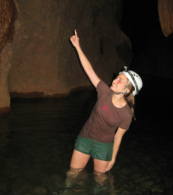All Creatures Great and Small- The Diversity of the Veterinarian Profession
December 01, 2011
By Natalie Punt Ever wished your pet was your homework? Companion animals are one aspect of the multi-dimensional and dynamic field of veterinarian medicine. Veterinarian medicine is one of the best jobs in America according to US News and Money magazines. It rates high as a meaningful and intellectually challenging career with opportunities for personal advancement and good compensation. Veterinarians are in high demand with a current shortage and forecasted 33% growth rate. Veterinarian medicine attracts individuals whom appreciate the details of an overall picture. As veterinarians treat every species except one- they possess global perspectives and knowledge. The writing of the well-known Scottish veterinarian, James Herriot idealized the relationship veterinarians have with animals. He identified the core value of veterinarians as an innate responsibility to care for animals and an obligation to protect animals. Veterinarians act as an animal’s Rosetta stone to interpret and translate animal behavior into medical language. To do so they must have a solid understanding of basic biology, physiology and some chemistry coupled with a detective’s intuition and a scientist’s logic. The unique perspectives shared within the profession naturally translate to innovation and discovery. Veterinarians have conquered malaria, yellow fever, discovered botulism, Salmonella, isolated tumor-causing viruses, anticoagulants to treat heart disease, developed surgical procedures for hip, knee, limb and organ replacements as well as discovered new animal and microorganism species. The primary responsibility of veterinarians is to protect the health and welfare of animals and people. Veterinarians use their animal expertise to make informed ethical decisions in regulating the use of animals in society. Their critical role in society is to diagnose and control infectious diseases, treat sick and injured animals, and advise owners of proper animal care including pets, working animals and livestock (AAVMC). Veterinarian career opportunities are diverse and available in a range of settings from small animal private practices in Manhattan, the National Institute of Health and rural large animal infectious disease testing in Tibet. Although 80% of veterinarians are in private clinical practice, opportunities are available in academia, zoos, aquariums, food safety, public policy, pharmaceutical and biomedical industries as well as government. Beyond the Clinic Veterinarians are uniquely qualified for biomedical research. Using basic biology to compare diseases across species- including humans, gives researchers a unique approach and distinct advantage when developing research models and translating research findings. Companion animals are beginning to play an increasingly larger role in biomedical research as many domestic animals share human diseases, such as cancer. Canine osteosarcoma is highly similar pediatric ostosarcoma allowing researchers to run clinical trials in veterinarian clinics prior to human clinics. Veterinarian work in public services ensures the nation’s food is safe for distribution. Veterinarians monitor populations of animals raised for human consumption to detect and prevent contaminations, toxins and especially infectious diseases. Public health veterinarians work with regulatory agencies and other medical workers to develop public health procedures to control zoonotic diseases and biological hazards. The increasing awareness of food safety and the treatment of food animals has placed greater importance on the role of veterinarians monitoring the interface of food animal and public health. Conservation and protection of endangered and threatened species is another esoteric role that veterinarians play in society. Conservation medicine is increasing in importance as human growth and modern technology decrease environmental quality resulting in disease. International conservation efforts are especially important in developing countries, as rapid development can affect wildlife species to the extent of eradication and severe genotypic alterations. Wild animal populations are also valuable to monitor bioindicators of environmental change and zoonoses. Veterinarians work to preserve the quality and diversity of threatened species by regulating the human impact on wildlife and providing clinical care. The extent of unintentional deleterious human effects on wildlife is surprising. A current study at Tufts School of Veterinarian examining the causes of lead poisoning in water fowl identified lead sinkers and lead shot as the leading causes of waterfowl death, particularly loons. Wildlife conservation also benefits from molecular and cellular techniques to improve reproduction. The white rhino has benefitted from advancements in stem cell technology and the giant panda has benefitted from sophisticated reproductive techniques to increase the number of live births in captivity. Veterinarian medicine is a broad profession that encourages talented individuals to explore a variety of interconnected subjects. Professionals can spend their career treating pets, studying cancer in snow leopards, monitoring the spread of infectious diseases in livestock and preserving endangered species through modern stem cell technologies. The commonality of medicine and animals is a strong bond that veterinarians share attracts individuals to the profession. --- Liked this article? Read more Op Eds! About the Author
Natalie Punt caught the science bug at her grammar school’s science fair and has been experimenting since. She followed her passion for model biological systems as a microbiology major at UC Davis. As an undergraduate, she exercised her dual love for chemistry and biology by spending her free time in the biochemistry department characterizing the enzymatic site of a meiotic homologous recombination enzyme in yeast and identifying a motility gene in Myxococcus. Natalie has developed and characterized a mouse model of tumor angiogenesis, engineered a 3-D model of tumor angiogenesis and most recently contributed to the characterization of the epigenetic regulation of Mixed Lineage Leukemia. Her work has earned recognition at numerous science conferences and publications in peer-reviewed journals. Natalie’s immediate research plan is to study the genetic differences in cancer between domesticated animals and humans as a veterinarian student in California. In her free time she enjoys running around the Charles, reading design books and learning to speak Italian.
Comments?
Photo Source
Dog: Image: posterize / FreeDigitalPhotos.net Vet: Image: photostock / FreeDigitalPhotos.net |
The Scientista Foundation, Inc. All Rights Reserved © 2011-2021 | Based in NY | [email protected]
The Network for Pre-Professional Women in Science and Engineering
The Scientista Foundation is a registered 501(c)(3) -- Donate!
The Network for Pre-Professional Women in Science and Engineering
The Scientista Foundation is a registered 501(c)(3) -- Donate!
